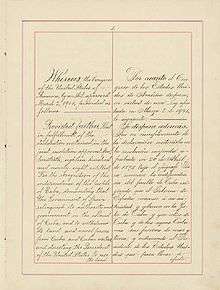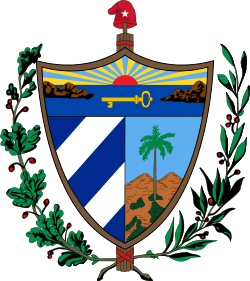Cuban–American Treaty of Relations (1903)

The Cuban–American Treaty of Relations agreed to in 1903 stipulates that the Republic of Cuba lease to the United States specific lands in Cuba, notably the land that surrounds Guantánamo Bay, for the purpose of coaling and naval stations, for as long as necessary. The lease stipulates that the United States "shall exercise complete jurisdiction and control", while recognizing "the continuance of the ultimate sovereignty of the Republic of Cuba". Cuban vessels involved in trade will have free passage through the waters. The United States has the right to modify the waters as necessary.
One lease that accomplished what the treaty contemplated had been executed earlier in the year and a second lease was executed later in the year.
Treaty of Relations
 Page one of the 1903 Treaty of Relations, including the Platt Amendment | |
| Signed | May 22, 1903 |
|---|---|
| Location | Havana |
| Effective | July 1, 1904 |
| Expiry | June 9, 1934 |
| Signatories | |
| Citations | 33 Stat. 2248; TS 437; 6 Bevans 1116 |
| Also known as the Permanent Treaty (6 Bevans 1126). Amended by supplementary convention of January 20, 1903 (TS 438; 6 Bevans 1123). Abrogated by the Treaty of Relations of 1934 on June 9, 1934 (TS 866; 6 Bevans 1161). | |
U.S. law directed the president to cede control of Cuba to its government only when that government had endorsed the seven provisions established in U.S. law by the Platt Amendment of March 1901. The 1903 Treaty of Relations noted that Cuba's Constitutional Convention had, on June 12, 1901, added the Platt Amendment provisions to its constitution on February 21, 1901. Those provisions, among other things, restricted the independence of the Cuban government and gave the U.S. the right to oversee and at times interfere in Cuban affairs. The Cuban government had taken power and the U.S. withdrawn its forces as of May 20, 1902.
The final provision of the Platt Amendment required that its provisions be adopted by treaty as well. The Treaty of Relations, signed in May 1903, accomplished that.
The 1903 Treaty of Relations was superseded by the 1934 Treaty of Relations, which abrogated in large measure the 1903 treaty while affirming the U.S. right to lease land for a naval station and continuing to hold the U.S. blameless for actions taken before the establishment of the Republic of Cuba in 1902.
American perspectives
The treaty fell short of the original desires of both the United States government and its military cabinet in Cuba.[1] Their aim was to lease four naval bases located in strategically favorable port areas of Cuba, including Guantánamo Bay. The other three were Bahia Honda (close to the Cuban capital of Havana), Cienfuegos, and Nipe Bay.[1]
Cuban perspectives
The government of Cuba argues[2] that the base is a constant affront to its sovereignty, taken under duress and maintained under the threat of atomic force. It has complained that weapons are smuggled into Cuba through the base and that the base shelters criminals fleeing from Cuban justice.
Cuban-American Professor Alfred-Maurice de Zayas argues that the lease may have been invalidated by material or fundamental breaches of its terms.[3] The February 1903 lease, in Article II, states that the United States is allowed "generally to do any and all things necessary to fit the premises for use as coaling or naval stations only, and for no other purpose." He questions whether the prison facility meet those criteria.
See also
References
- 1 2 "Leasing of U.S. Base Guantánamo Bay". Suburban Emergency Management Project. January 29, 2010. Retrieved December 19, 2010. [Dead link]
- ↑ US Joint Publications Research Service, 1977, pdf, English translation of 1970 Spanish document "Crimes and Provocations". Selected official comments made from 1960-1963, regarding the US occupation of Cuba, starting at page 31
- ↑ The Status Of Guantánamo Bay And The Status Of The Detainees, Alfred de Zayas. November 19, 2003 presentation
External links
- Cuban-American treaty, 1903 (full text)
- Lease text, 1903 (full text)
